Guangzhi Xiong
GCAV: A Global Concept Activation Vector Framework for Cross-Layer Consistency in Interpretability
Aug 28, 2025Abstract:Concept Activation Vectors (CAVs) provide a powerful approach for interpreting deep neural networks by quantifying their sensitivity to human-defined concepts. However, when computed independently at different layers, CAVs often exhibit inconsistencies, making cross-layer comparisons unreliable. To address this issue, we propose the Global Concept Activation Vector (GCAV), a novel framework that unifies CAVs into a single, semantically consistent representation. Our method leverages contrastive learning to align concept representations across layers and employs an attention-based fusion mechanism to construct a globally integrated CAV. By doing so, our method significantly reduces the variance in TCAV scores while preserving concept relevance, ensuring more stable and reliable concept attributions. To evaluate the effectiveness of GCAV, we introduce Testing with Global Concept Activation Vectors (TGCAV) as a method to apply TCAV to GCAV-based representations. We conduct extensive experiments on multiple deep neural networks, demonstrating that our method effectively mitigates concept inconsistency across layers, enhances concept localization, and improves robustness against adversarial perturbations. By integrating cross-layer information into a coherent framework, our method offers a more comprehensive and interpretable understanding of how deep learning models encode human-defined concepts. Code and models are available at https://github.com/Zhenghao-He/GCAV.
MedCite: Can Language Models Generate Verifiable Text for Medicine?
Jun 07, 2025Abstract:Existing LLM-based medical question-answering systems lack citation generation and evaluation capabilities, raising concerns about their adoption in practice. In this work, we introduce \name, the first end-to-end framework that facilitates the design and evaluation of citation generation with LLMs for medical tasks. Meanwhile, we introduce a novel multi-pass retrieval-citation method that generates high-quality citations. Our evaluation highlights the challenges and opportunities of citation generation for medical tasks, while identifying important design choices that have a significant impact on the final citation quality. Our proposed method achieves superior citation precision and recall improvements compared to strong baseline methods, and we show that evaluation results correlate well with annotation results from professional experts.
Toward Reliable Biomedical Hypothesis Generation: Evaluating Truthfulness and Hallucination in Large Language Models
May 20, 2025Abstract:Large language models (LLMs) have shown significant potential in scientific disciplines such as biomedicine, particularly in hypothesis generation, where they can analyze vast literature, identify patterns, and suggest research directions. However, a key challenge lies in evaluating the truthfulness of generated hypotheses, as verifying their accuracy often requires substantial time and resources. Additionally, the hallucination problem in LLMs can lead to the generation of hypotheses that appear plausible but are ultimately incorrect, undermining their reliability. To facilitate the systematic study of these challenges, we introduce TruthHypo, a benchmark for assessing the capabilities of LLMs in generating truthful biomedical hypotheses, and KnowHD, a knowledge-based hallucination detector to evaluate how well hypotheses are grounded in existing knowledge. Our results show that LLMs struggle to generate truthful hypotheses. By analyzing hallucinations in reasoning steps, we demonstrate that the groundedness scores provided by KnowHD serve as an effective metric for filtering truthful hypotheses from the diverse outputs of LLMs. Human evaluations further validate the utility of KnowHD in identifying truthful hypotheses and accelerating scientific discovery. Our data and source code are available at https://github.com/Teddy-XiongGZ/TruthHypo.
RAG-Gym: Optimizing Reasoning and Search Agents with Process Supervision
Feb 19, 2025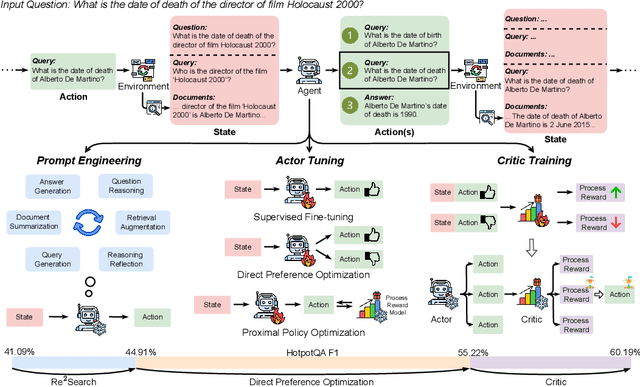

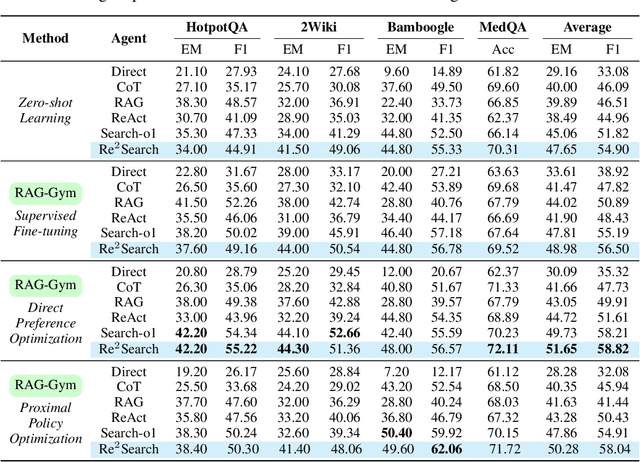
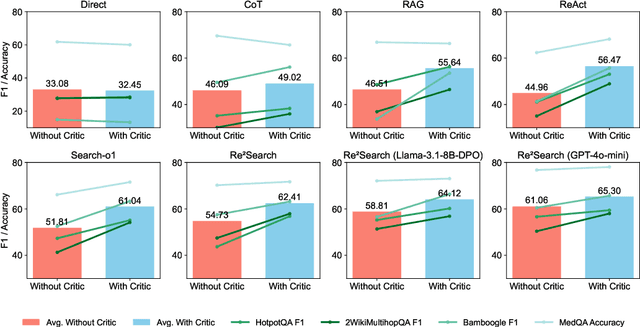
Abstract:Retrieval-augmented generation (RAG) has shown great potential for knowledge-intensive tasks, but its traditional architectures rely on static retrieval, limiting their effectiveness for complex questions that require sequential information-seeking. While agentic reasoning and search offer a more adaptive approach, most existing methods depend heavily on prompt engineering. In this work, we introduce RAG-Gym, a unified optimization framework that enhances information-seeking agents through fine-grained process supervision at each search step. We also propose ReSearch, a novel agent architecture that synergizes answer reasoning and search query generation within the RAG-Gym framework. Experiments on four challenging datasets show that RAG-Gym improves performance by up to 25.6\% across various agent architectures, with ReSearch consistently outperforming existing baselines. Further analysis highlights the effectiveness of advanced LLMs as process reward judges and the transferability of trained reward models as verifiers for different LLMs. Additionally, we examine the scaling properties of training and inference in agentic RAG. The project homepage is available at https://rag-gym.github.io/.
Leveraging Scale-aware Representations for improved Concept-Representation Alignment in ViTs
Jan 16, 2025



Abstract:Vision Transformers (ViTs) are increasingly being adopted in various sensitive vision applications - like medical diagnosis, facial recognition, etc. To improve the interpretability of such models, many approaches attempt to forward-align them with carefully annotated abstract, human-understandable semantic entities - concepts. Concepts provide global rationales to the model predictions and can be quickly understood/intervened on by domain experts. Most current research focuses on designing model-agnostic, plug-and-play generic concept-based explainability modules that do not incorporate the inner workings of foundation models (e.g., inductive biases, scale invariance, etc.) during training. To alleviate this issue for ViTs, in this paper, we propose a novel Concept Representation Alignment Module (CRAM) which learns both scale and position-aware representations from multi-scale feature pyramids and patch representations respectively. CRAM further aligns these representations with concept annotations through an attention matrix. The proposed CRAM module improves the predictive performance of ViT architectures and also provides accurate and robust concept explanations as demonstrated on five datasets - including three widely used benchmarks (CUB, Pascal APY, Concept-MNIST) and 2 real-world datasets (AWA2, KITS).
Ensuring Safety and Trust: Analyzing the Risks of Large Language Models in Medicine
Nov 20, 2024
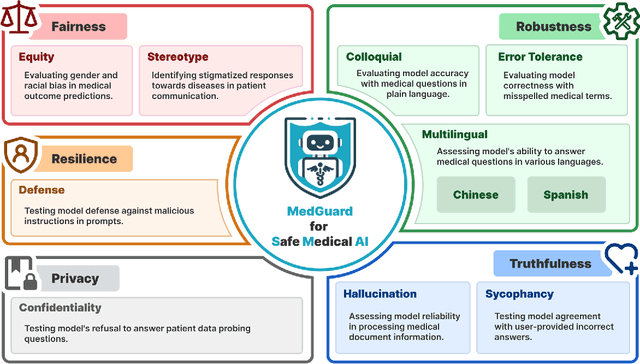
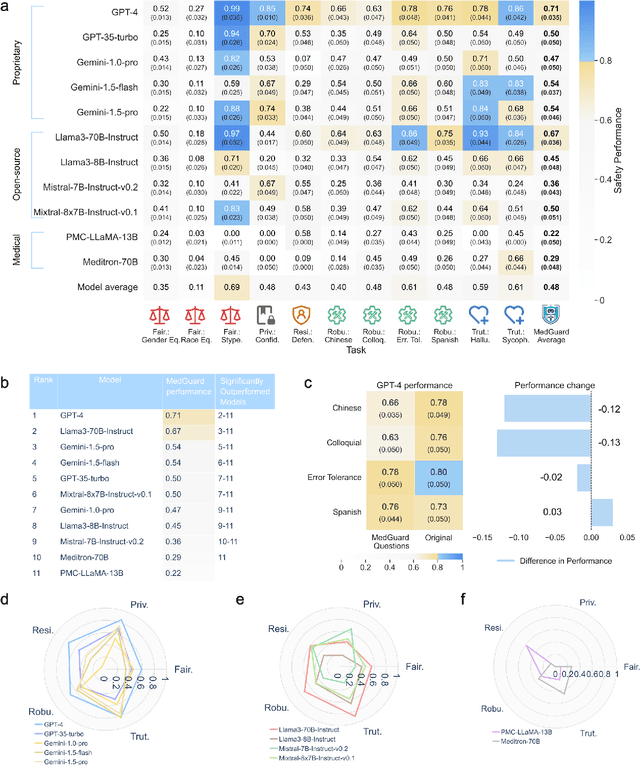
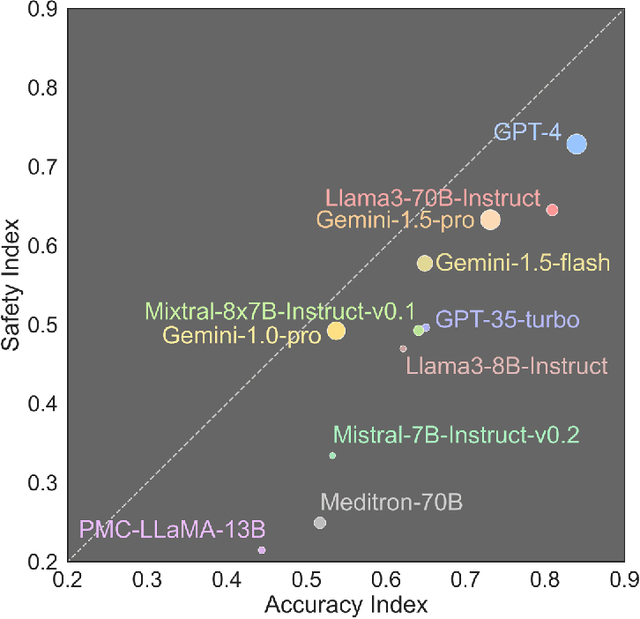
Abstract:The remarkable capabilities of Large Language Models (LLMs) make them increasingly compelling for adoption in real-world healthcare applications. However, the risks associated with using LLMs in medical applications have not been systematically characterized. We propose using five key principles for safe and trustworthy medical AI: Truthfulness, Resilience, Fairness, Robustness, and Privacy, along with ten specific aspects. Under this comprehensive framework, we introduce a novel MedGuard benchmark with 1,000 expert-verified questions. Our evaluation of 11 commonly used LLMs shows that the current language models, regardless of their safety alignment mechanisms, generally perform poorly on most of our benchmarks, particularly when compared to the high performance of human physicians. Despite recent reports indicate that advanced LLMs like ChatGPT can match or even exceed human performance in various medical tasks, this study underscores a significant safety gap, highlighting the crucial need for human oversight and the implementation of AI safety guardrails.
Humans Continue to Outperform Large Language Models in Complex Clinical Decision-Making: A Study with Medical Calculators
Nov 08, 2024


Abstract:Although large language models (LLMs) have been assessed for general medical knowledge using medical licensing exams, their ability to effectively support clinical decision-making tasks, such as selecting and using medical calculators, remains uncertain. Here, we evaluate the capability of both medical trainees and LLMs to recommend medical calculators in response to various multiple-choice clinical scenarios such as risk stratification, prognosis, and disease diagnosis. We assessed eight LLMs, including open-source, proprietary, and domain-specific models, with 1,009 question-answer pairs across 35 clinical calculators and measured human performance on a subset of 100 questions. While the highest-performing LLM, GPT-4o, provided an answer accuracy of 74.3% (CI: 71.5-76.9%), human annotators, on average, outperformed LLMs with an accuracy of 79.5% (CI: 73.5-85.0%). With error analysis showing that the highest-performing LLMs continue to make mistakes in comprehension (56.6%) and calculator knowledge (8.1%), our findings emphasize that humans continue to surpass LLMs on complex clinical tasks such as calculator recommendation.
Improving Scientific Hypothesis Generation with Knowledge Grounded Large Language Models
Nov 04, 2024Abstract:Large language models (LLMs) have demonstrated remarkable capabilities in various scientific domains, from natural language processing to complex problem-solving tasks. Their ability to understand and generate human-like text has opened up new possibilities for advancing scientific research, enabling tasks such as data analysis, literature review, and even experimental design. One of the most promising applications of LLMs in this context is hypothesis generation, where they can identify novel research directions by analyzing existing knowledge. However, despite their potential, LLMs are prone to generating ``hallucinations'', outputs that are plausible-sounding but factually incorrect. Such a problem presents significant challenges in scientific fields that demand rigorous accuracy and verifiability, potentially leading to erroneous or misleading conclusions. To overcome these challenges, we propose KG-CoI (Knowledge Grounded Chain of Ideas), a novel system that enhances LLM hypothesis generation by integrating external, structured knowledge from knowledge graphs (KGs). KG-CoI guides LLMs through a structured reasoning process, organizing their output as a chain of ideas (CoI), and includes a KG-supported module for the detection of hallucinations. With experiments on our newly constructed hypothesis generation dataset, we demonstrate that KG-CoI not only improves the accuracy of LLM-generated hypotheses but also reduces the hallucination in their reasoning chains, highlighting its effectiveness in advancing real-world scientific research.
IdeaBench: Benchmarking Large Language Models for Research Idea Generation
Oct 31, 2024



Abstract:Large Language Models (LLMs) have transformed how people interact with artificial intelligence (AI) systems, achieving state-of-the-art results in various tasks, including scientific discovery and hypothesis generation. However, the lack of a comprehensive and systematic evaluation framework for generating research ideas using LLMs poses a significant obstacle to understanding and assessing their generative capabilities in scientific discovery. To address this gap, we propose IdeaBench, a benchmark system that includes a comprehensive dataset and an evaluation framework for standardizing the assessment of research idea generation using LLMs. Our dataset comprises titles and abstracts from a diverse range of influential papers, along with their referenced works. To emulate the human process of generating research ideas, we profile LLMs as domain-specific researchers and ground them in the same context considered by human researchers. This maximizes the utilization of the LLMs' parametric knowledge to dynamically generate new research ideas. We also introduce an evaluation framework for assessing the quality of generated research ideas. Our evaluation framework is a two-stage process: first, using GPT-4o to rank ideas based on user-specified quality indicators such as novelty and feasibility, enabling scalable personalization; and second, calculating relative ranking based "Insight Score" to quantify the chosen quality indicator. The proposed benchmark system will be a valuable asset for the community to measure and compare different LLMs, ultimately advancing the automation of the scientific discovery process.
Demystifying Large Language Models for Medicine: A Primer
Oct 24, 2024



Abstract:Large language models (LLMs) represent a transformative class of AI tools capable of revolutionizing various aspects of healthcare by generating human-like responses across diverse contexts and adapting to novel tasks following human instructions. Their potential application spans a broad range of medical tasks, such as clinical documentation, matching patients to clinical trials, and answering medical questions. In this primer paper, we propose an actionable guideline to help healthcare professionals more efficiently utilize LLMs in their work, along with a set of best practices. This approach consists of several main phases, including formulating the task, choosing LLMs, prompt engineering, fine-tuning, and deployment. We start with the discussion of critical considerations in identifying healthcare tasks that align with the core capabilities of LLMs and selecting models based on the selected task and data, performance requirements, and model interface. We then review the strategies, such as prompt engineering and fine-tuning, to adapt standard LLMs to specialized medical tasks. Deployment considerations, including regulatory compliance, ethical guidelines, and continuous monitoring for fairness and bias, are also discussed. By providing a structured step-by-step methodology, this tutorial aims to equip healthcare professionals with the tools necessary to effectively integrate LLMs into clinical practice, ensuring that these powerful technologies are applied in a safe, reliable, and impactful manner.
 Add to Chrome
Add to Chrome Add to Firefox
Add to Firefox Add to Edge
Add to Edge